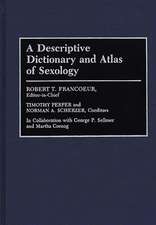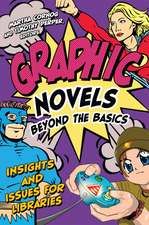Mangatopia: Essays on Manga and Anime in the Modern World
Editat de Timothy Perper, Martha Cornogen Limba Engleză Paperback – 23 oct 2011 – vârsta până la 17 ani
Preț: 319.19 lei
Preț vechi: 390.83 lei
-18% Nou
Puncte Express: 479
Preț estimativ în valută:
61.08€ • 66.33$ • 51.31£
61.08€ • 66.33$ • 51.31£
Carte tipărită la comandă
Livrare economică 22 aprilie-06 mai
Preluare comenzi: 021 569.72.76
Specificații
ISBN-13: 9781591589082
ISBN-10: 1591589088
Pagini: 276
Ilustrații: 20 bw illus
Dimensiuni: 156 x 235 x 15 mm
Greutate: 0.39 kg
Editura: Bloomsbury Publishing
Colecția Libraries Unlimited
Locul publicării:New York, United States
ISBN-10: 1591589088
Pagini: 276
Ilustrații: 20 bw illus
Dimensiuni: 156 x 235 x 15 mm
Greutate: 0.39 kg
Editura: Bloomsbury Publishing
Colecția Libraries Unlimited
Locul publicării:New York, United States
Caracteristici
Contributions from knowledgeable commentators about manga and anime from the United States, Canada, and Europe
Notă biografică
Timothy Perper, PhD, and Martha Cornog, MA, MLS, were review and commentary editors for Mechademia: An Annual Forum for Anime, Manga, and the Fan Arts for six years. They have both published several scholarly works about courtship and love in manga and anime.
Cuprins
When Akira, Ghost in the Shell, and Sailor Moon arrived in the United States from Japan in the 1990s, manga and anime entered a transnational flow of cultural goods that spiraled outwards into ever more complex loops of influence, fandom, and marketing (Matsui 2009). By then, manga and anime had already crossed the horizons of European popular art and culture (Pellitteri 2010 and Marco Pellitteri, , this volume) and had likewise reached Southeast Asian audiences and markets (Wong 2006). In one direction of the arrow, none of this was new; Raoul Walsh's 1924 silent film The Thief of Baghdad, which starred Douglas Fairbanks, had within two years been adapted and remade as an animated film in Japan: Noburo O fuji's 1926 Bagadajo no tozoku (The Thief of Baghdad Castle; see Miyao 2007). But what has made the manga and anime explosion of recent years different is that now Japan, and increasingly Korea and China, are exporting cultural goods to the Eurocentric Western world-and with extravagant aesthetic, cultural, and commercial success.For at least some U.S. critics, journalists, and commercial commentators, manga and anime have constituted a bewildering intrusion or even challenge to the unquestioned (although parochial) view that U.S. production values embody the worldwide standard for comics and for animation. How could anyone else excel at cartoons when Superman and Batman define the comics, or when Fantasia and 101 Dalmatians define animation? If Who Framed Roger Rabbit was the 1988 ne plus ultra of innovative filmmaking, what was this Akira thing all about? The college students who formed the first definable fanbase for anime in the United States had it right when they said that they'd never seen anything like this before (Napier 2005). But they loved it-together with Robotech, Ninja Scroll, and Neon Genesis Evangelion.But more astonishments lay ahead. The hero-worshipping boys who were Robotech's and Gundam's first fans had sisters. And the sisters and their female friends adored Sailor Moon-and then Cardcaptor Sakura, Fruits Basket, and FAKE. By today, girls and young women form a large percentage of the manga/anime fanbase, a striking change from a three-decades historical predominance of young males in U.S. comics fandom (Robbins 2009). Because European experience with manga and anime predated U.S. familiarity, older continental women have maintained their enthusiasm for these Japanese art-forms, leading to extensive translation and publication in France, Italy, Spain, and Germany of manga originally written by adult women for adult women-the genres called josei and rediisu (see Kinko Ito, , this volume, for a biographical discussion of Chikae Ide, a major josei manga artist).Simultaneously, a shift occurred in cartoon and comics criticism both in the United States and in Europe. Moving from an outlaw child of establishment print and publishing, comics and cartooning criticism renewed itself, a process greatly helped by the Internet and by blogging. It was difficult for alert critics to ignore the simply stunning beauty of animated films such as Hayao Miyazaki's 1997 Princess Mononoke and Mamoru Oshii's 2004 Innocence-or, more recently, Kenji Kamiyama's 2007 Seirei no moribito (see Paul Jackson, , this volume). Some earlier commentators, such as Ivan Stang (1988, 257-58), had foreseen the potential impact of anime such as Yoshiaki Kawajiri's 1984 Lensman, a masterpiece of over-the-top swashbuckling romance, adventure, and comedy, including a scene unequalled in animation of a riot in a discotheque.Part of this shift in comics criticism produced theories about how cartooning works and achieves its effects, including writing by Scott McCloud, Neil Cohn (http://www.webcomicsnation.com/NeilCohn), and Alan Cholodenko, among others (Cholodenko 1991, 2007; McCloud 1993). In turn, their work stimulated further theoretical analysis, for example, by Thomas LaMarre and by Deborah Shamoon (some in this volume; see also LaMarre 2009). Much work of this kind is being published in Mechademia: An Annual Forum for Anime, Manga, and the Fan Arts (http://www.mechademia.org), several of whose editors are represented in this collection: Frenchy Lunning, herself the editor of Mechademia, Thomas LaMarre, Patrick Drazen, and ourselves.So manga and anime did more than entertain an increasing number of ardent fans in the United States and Europe. Manga and anime also forced Western viewers and critics to revision the nature of cartooning, comics, and animation. In part, the revisioning has occurred because manga and anime overtly combine political, social, and emotional issues into narrative entireties, in stark contrast to the kiddie fare of Saturday morning cartoons on U.S. television.But this combination has characterized manga from the early post-World War II days of Osamu Tezuka (see Ada Palmer, , and William Benzon, , in this volume) and is central to both right-wing and left-wing views of manga (see Matthew Penney, , this volume). No one can ignore the politics of emotionality when the subject matter of manga is the bombing of Hiroshima (see Thomas LaMarre, , this volume).Nor can one ignore the history of Japanese art when looking at manga and anime. Transnational flows of influence may have arrived in Japan from the United States and Europe, but, equally, Japanese art has, since the 19th century, influenced Eurocentric art-for example, as Japonisme in France (Wichmann 1999). But manga and anime have been, if not immune, then relatively indifferent, to two of the cornerstones of modern Eurocentric art.One is abstractionism, dating roughly from 1900 to 1910 in Europe, central to work by Pablo Picasso and Georges Braque. But far more than drawing on European models of abstract art, manga and anime depend on recognizably Japanese forms of minimalism and abstraction-which Westerners may recognize only at a distance when gazing uncertainly at flower arranging and wondering what it means. Many viewers, we imagine, do not make complex aesthetic assessments when they watch giant robots stomping through the landscape or when they watch some poor high school lad torn between the seductions of two equally pretty heroines. But the minimalism is there, in a succinct focus on the image, on its symmetry, and on an elegance of line and coloring that wastes no space or effort. So we are grateful when scholars such as Deborah Shamoon and Thomas LaMarre ( and , respectively, in this volume) explicate the origins and nature of some of these techniques.But above all, manga and anime have not abandoned realism with the enthusiasm with which Eurocentric art surrendered to the blandishments of abstractionism. Of course, abstract, even surreal, manga and anime exist, some of them masterpieces, such as Kazuya Tsurumaki's 2000 FLCL and Kunihiko Ikuhara's 1999 film Revolutionary Girl Utena: Adolescence Apocalypse. But even Utena remains rooted in realism, as do manga and anime stories of demons, aliens, yokai, robots, androids, dakini, and a mind-boggling array of other beings all inhabiting the interstices of modern Tokyo-or in Armitage, Mars.Such realism transcends the definitions of 19th century European art of the kind where the French realist painter Gustave Courbet was asked to paint an angel and he replied, "Show me an angel and I will paint one" ("Courbet, Gustave" 2004). For Courbetian realism, art is "what my eyes see" (Clair 2003): the objects of art must exist in the mundane here-and-now of this physical world, for otherwise they are aesthetically empty phantasms and hallucinations.The counter-reply is not that worlds without fantasy are boring; nor is the answer that fantasy contains Truths of the Inner Mind inaccessible through literalism and accessible only symbolically, as Jung might have said (Jung et al. 1968). Instead, one answer to Courbet's realism is aesthetic, not psychological: animated films such as Akira, Ghost in the Shell, and Sailor Moon are drawn with impeccable stylishness and with detailed, loving attention to verisimilitude, and yet they are fantasies vivid, immediate, and real. Anime and manga have a tangible realism where sword-swinging heroines such as Utena (Perper and Cornog 2008) seem to be sitting in the artist's studio having their portraits painted. Such art provides an aesthetically realist-and visually realistic-map of the impossible. Paul Jackson (, this volume) shows how folklore and tradition combine with computer graphics in a hyperrealism beyond the real to create worlds never seen before-but which become familiar and appealing to us in exquisite detail. It is a very new aesthetic we see here: a semiotic revolution where meanings spiraling back and forth across the world reassemble themselves into new forms and representations of reality, imagined or not.And, in the meantime, the fans are running around having a wonderful time. Yet, in a nice complement to the complexities of the art itself, fan culture is neither simple nor pure joyousness. A great deal is involved in the fan custom of dressing up like your favorite anime character at a fan convention (cosplay or costume-play; see Frenchy Lunning, , this volume). Fans make nuanced and complex decisions and evaluations about what they see (see Patrick Drazen, , this volume). They also write and draw their own fan art. Some of it startles outsiders, such as the "male homosexuality" of yaoi and BL, acronyms for art drawn by women artists and read by women, showing male-male romances and sexual engagements. Three of our contributors expand on yaoi and BL: Robin Brenner, Snow Wildsmith, and Mark McHarry.At every point, we perceive not a static system of media engorgement at the expense of the consumer but a dialectical process of exchange among artist, society, and audience. By dialectical, we mean that richly entwined interactions among artist, society, and audience have shaped manga and anime first in Japan and now across the world. One should, we suggest, forget about linear models of social function when dealing with such complexities. For example, Ryutaro Nakamura's 2007 anime Ghost Hound involves-among other things!-a secret government laboratory hidden in the mountains creating artificial life for unknown but undoubtedly noxious reasons. The sudden manifestation of these artificial beings draws down upon itself the renewed and intensified curiosity of various other beings, including a tengu demon who lives in these mountains, some high school students, a pretty girl medium exploited by the bad guys, yakuza mobsters, and a group of Buddhist monks who watch the denouement while floating serenely in mid-air. No, not linear.not at all, especially not when the artificial creatures escape at the end, coalesce into two flying dragons who entwine in an unmistakable embrace, and then disappear into a hole in the sky. There, we assume, they will rear baby dragons.Do you think it might be a metaphor?Increasingly, libraries and librarians have become aware of manga and anime. These art-forms are hard to ignore when, as one librarian exclaimed, "I have kids in a piranha pack coming upstairs, clawing their way to the [graphic novel] collection!" (audience member, New York Comic-Con, 2008). A mixed metaphor, but vivid nonetheless: scholarly attention, fan enthusiasm, and unparalleled commercial success for manga and anime have converged to create a need for good information. So we assembled this collection of essays to showcase discussions of manga and anime not just for librarians but for all intelligent readers interested in the future of the book and the story. We asked a number of manga and anime experts, some academics, some not, to write about topics of their choice, with the understanding that the result should be insightful, informative, and interesting. And they did.So enjoy their essays. They are-above all-well-written and thoughtful analyses of the complexities of manga and anime in the modern world.REFERENCESCholodenko, Alan, ed. 1991. The Illusion of Life: Essays on Animation. Sydney, Australia: Power Publications and the Australian Film Commission.Cholodenko, Alan, ed. 2007. The Illusion of Life 2: More Essays on Animation. Champaign: University of Illinois Press.Clair, Jean. 2003. "Femalic Molds." Translated by Taylor M. Stapleton. tout-fait: The Marcel Duchamp Studies Online Journal 2 (5). Available at: http://www.toutfait.com/issues/volume2/issue_5/news/clair/clair.html. (Originally published in [Sur] Marcel Duchamps et le fin de l'art. Paris: Gallimard, 2000.)"Courbet, Gustave." 2004. The Oxford Dictionary of Art. Edited by Ian Chilvers. Oxford: Oxford University Press. Available at: http://www.enotes.com/oxford-art-encyclopedia/courbet-gustave.Jung, Carl G., M.-L. von Franz, Joseph L. Henderson, Jolande Jacobi, and Aniela Jaffé. 1968. Man and His Symbols. New York: Dell.LaMarre, Thomas. 2009. The Anime Machine: A Media Theory of Animation. Minneapolis: University of Minnesota Press.Matsui, Takeshi. 2009. The Diffusion of Foreign Cultural Products: The Case Analysis of Japanese Comics (Manga) Market in the US. Working Paper 37. Available at: http://www.princeton.edu/~artspol/workpap37.html.McCloud, Scott. 1993. Understanding Comics: The Invisible Art. Northampton, MA: Kitchen Sink Press.Miyao, Daisuke. 2007. "Thieves of Baghdad: Translational Networks of Cinema and Anime in the 1920s." Mechademia 2: 83-103.Napier, Susan. 2005. Anime from Akira to Howl's Moving Castle: Experiencing Contemporary Japanese Animation. Rev. ed. New York: Palgrave Macmillan.Pellitteri, Marco. 2010. The Dragon and the Dazzle: Models, Strategies, and Identities of Japanese Imagination-A European Perspective. Translated by Roberto Branca with Christie Lee Barber. Latina, Italy: Tunué. (Originally published as Il drago e la saetta. Modelli, strategie e identità dell'immaginario giapponese. Latina: Tunué, 2008.)Perper, Timothy, and Martha Cornog. 2008. "'I Never Said I Was a Boy': Utena, Arita Forland, and the (Non) Phallic Woman." International Journal of Comic Art 10 (2): 328-53.Robbins, Trina. 2009. "Girls, Women, and Comics." In Graphic Novels Beyond the Basics: Issues and Insights for Libraries. Edited by Martha Cornog and Timothy Perper, 45-60. Santa Barbara, CA: ABC-CLIO/Libraries Unlimited.Stang, Ivan. 1988. High Weirdness by Mail. New York: Fireside.Wichmann, Siegfried. 1999. Japonisme: The Japanese Influence on Western Art since 1858. Translated by Mary Whittall, James Ramsay, Helen Watanabe, Cornelius Cardew, and Susan Bruni. London: Thames and Hudson.Wong, Wendy Siuyi. 2006. "Globalizing Manga: From Japan to Hong Kong and Beyond." Mechademia 1: 23-45.
Recenzii
This is a most interesting compilation of information about manga and anime. . . . Various essays are thought provoking not only to professionals, but also to parents and students. Don't miss this one!



















